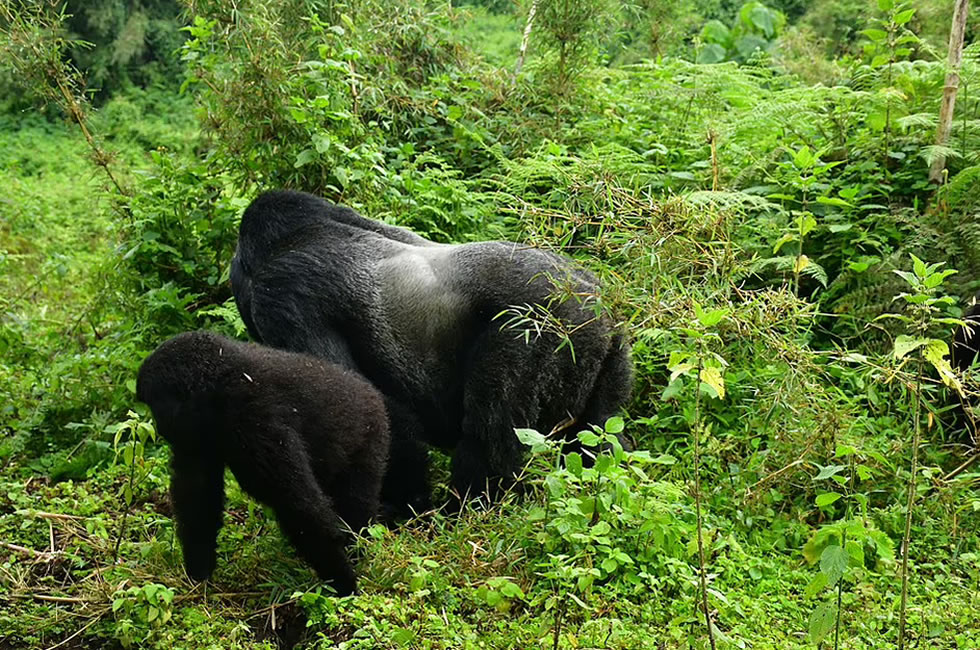- On a recent visit to Rwanda, I went on a trek to find the country’s most famous animal inhabitant – the mountain gorilla, the world’s largest primate.
- The adventure took place in the thickly vegetated Volcanoes National Park Rwanda and we finally came face to face with a family of gorillas after 30 minutes or so.
Mail Online Travel’s Sadie Whitelocks went on a magical gorilla trekking expedition in Volcanoes National Park Rwanda, and after a short time met a troop of gorillas that included a mother and her one-month-old infant, captured by Sadie in the picture above.
Sadie describes how her heart was pounding as her small group approached the family of gorillas. Above is another shot of the adorable one-month-old infant in the group
Sadie writes of her gorilla encounter (above left and right): ‘It was like being in a scene from a David Attenborough documentary and our gorilla trekking group sat there in silence for around an hour, in awe of the gorillas’ beauty and their mesmerisingly human-like traits.’ A 2016 census revealed there were around 600 gorillas in the Virunga Massif, a chain of volcanoes spanning the northern border of Rwanda, the DR Congo, and Uganda.
We knew we were getting close when we began hearing excitable grunts, howls and screeches. It was difficult, though, to pinpoint where they were coming from given the density of weed-strewn trees and clumps of bamboo.
My heart was pounding.
Then, as we turned a corner, our guide Jolie warned us to slow down and be quiet as a family of gorillas came into view. There was a mother rolling around with a tiny one-month-old, a car-sized silverback munching on leaves and several more of his hareem scattered around.
It was like being in a scene from a David Attenborough documentary and our gorilla trekking group sat there in silence for around an hour, in awe of the gorillas’ beauty and their mesmerisingly human-like traits.
Before setting off, one elderly lady in our group explained that visiting Rwanda’s gorillas was one of her bucket-list items, but like many, she had to put her dreams on hold due to the pandemic.
Now the country has reopened – with rapid Covid-19 tests being the only requirement – and tourists are steadily returning to feast on its offerings.
It was magical being so close to the gorillas but at the same time, I felt slightly guilty about venturing into their habitat with cameras clicking away.
Sadie says that she felt guilty venturing into the gorillas’ habitat ‘with cameras clicking away’, but conservationist Veronica Vecellio from the Dian Fossey Gorilla Fund told her that the interactions do not stress the animals. Pictured left is the mother gorilla with her one-month infant and on the right, a silverback.
Conservation expert Vecellion told Sadie that the gorillas had probably had a ‘party’ while the tourists were away during the pandemic but at the same time, ‘tourism helps with the Rwandan economy and to educate people about habitat loss, poaching and the importance of protecting our environment’. Above is another shot Sadie took of the mother gorilla cuddling her infant
Veronica Vecellio, a conservation expert I spoke to from the Dian Fossey Gorilla Fund (a non-profit founded by the late American primatologist and conservationist Dian Fossey), admitted that the gorillas had probably had a ‘party’ while the tourists were away but at the same time, ‘tourism helps with the Rwandan economy and to educate people about habitat loss, poaching and the importance of protecting our environment’.
She added: ‘There have been studies around the proximity of humans to gorillas, with cortisol levels monitored, and it was found that there was no stress caused by interactions.
‘Gorillas are extremely smart and know that we are there but they are not alarmed. This is the sign of a well-managed habituation project whereby the gorillas are exposed to humans. Our work is helping to keep the species alive.
‘In the 2016 census there were around 600 gorillas in the Virunga Massif [a chain of volcanoes spanning the northern border of Rwanda, the DR Congo, and Uganda], but now we expect there to be lots more.’
My gorilla trekking encounter had taken place on my third day in Rwanda, and before that, I’d decided to explore a lesser-visited spot – dormant volcano Mount Karisimbi.





